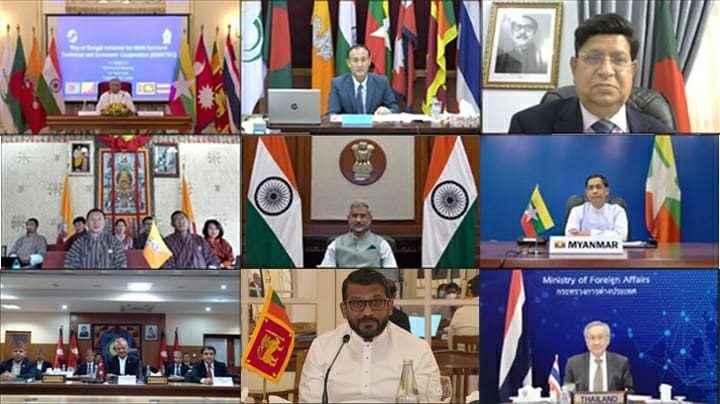
BIMSTEC MINISTERIAL MEETING
Context
Recently, the External Affairs Minister of India participated in the 17th Bay of Bengal Initiative for Multi-Sectorial Technical and Economic Cooperation (BIMSTEC) Ministerial Meeting.
More about News
BIMSTEC Convention on Cooperation in Combating International Terrorism, Transnational Organized Crime and illicit Drug Trafficking has come into force in March 2021.
Also, BIMSTEC Convention on Mutual Legal Assistance in Criminal Matters has been finalized for signing at the fifth BIMSTEC Summit.
These Conventions will provide a robust legal basis to further strengthen our cooperation in this sector.
BIMSTEC Centre for Weather and Climate, being hosted in India, is fully functional with state of the art facilities to provide Disaster Early Warning.
BIMSTEC FORMATION
BIMSTEC is an economic bloc that came into being on 6 June 1997 through the Bangkok Declaration.
It aims to accelerate economic growth and social progress among members across multiple sectors — trade, technology, energy, transport, tourism and fisheries, agriculture, public health, poverty alleviation, counter-terrorism, environment, culture, people to people contact and climate change.
The grouping holds annual meetings hosted by member states based on alphabetical rotation. Sri Lanka is the host nation this time
Initially, the economic bloc was formed with four countries with the acronym ‘BIST-EC’ (Bangladesh, India, Sri Lanka and Thailand Economic Cooperation). With the entrance of Myanmar in 1997, the grouping was renamed ‘BIMST-EC’ (Bangladesh, India, Myanmar, Sri Lanka and Thailand Economic Cooperation).
Finally, with the entrance of Nepal and Bhutan at the 6th Ministerial Meeting in 2004, the grouping was named Bay of Bengal Initiative for Multi-Sectorial Technical and Economic Cooperation (BIMSTEC).
Some key agreements signed by BIMSTEC members include a convention for combating terrorism, transnational organized crime and illicit drug trafficking. However, this awaits ratification.
o Another is the BIMSTEC Grid Interconnection, signed during the BIMSTEC Summit in Kathmandu, Nepal, in 2018, which aims to promote an optimal power transmission in the BIMSTEC region.
SIGNIFICANCE OF BIMSTEC
Stagnation of SAARC is a key reason for India to reach out to BIMSTEC as the stagnation limited the scope of India’s growing economic aspirations as well as the role it could play in improving regional governance.
BIMSTEC also carries a lot of economic promise – The BIMSTEC countries have combined gross domestic product (GDP) close to $2.7 trillion.
o Despite an adverse global financial environment, all seven countries were able to sustain average annual rates of economic growth between 3.4 and 7.5 percent from 2012 to 2016.
o The Bay of Bengal is also rich in untapped natural resources, with reserves of gas and other seabed minerals, oil and also fishing stocks.
Better connectivity with BIMSTEC countries opens up opportunities for Indian coastal states and North East states to unlock the potential for development in the region.
Strategically, BIMSTEC is a platform to counter assertive China in South and Southeast Asia, where it has undertaken investments through the Belt and Road initiative.
CRITICISM
India’s engagement with them has been mostly episodic and ad hoc. We have not created the capacity to engage with our neighbors on a sustained basis and at multiple levels.
Indian dilemma – The connectivity platform also opens the door to China selling its ambitious OBOR initiative.
Recently in the first ever military exercise of BIMSTEC, Nepal and Thailand did not send their army chiefs, only observers. Nepal arranged military exercise with China next week.
Delivery Deficit – India’s own resources are limited, but more than that its record of delivery on commitments continues to be abysmal.
Same projects reappearing as “fresh initiatives” in serial joint statements over recent years. Our capacities and institutions continue to lag behind our ambitions. It is time to move from an eventoriented to a process-driven approach.
According to envoys of member countries of BIMSTEC, the organization suffers from lack of visibility.
Given the geo-strategic importance of BIMSTEC countries – India should take a proactive and pragmatic approach to the regional grouping.
There is no department set-up to oversee BIMSTEC. If we want to see connectivity with neighboring countries, we need to integrate it in our own planning process.
